Report on Promoting Equality, Diversity, and Inclusion at Workplace
VerifiedAdded on 2021/02/20
|5
|1157
|63
Report
AI Summary
This report provides a comprehensive overview of equality, diversity, and inclusion (EDI) in the workplace. Part A addresses key questions, defining EDI, exploring its benefits, and outlining the consequences of non-compliance with equality legislation. It clarifies the roles and responsibilities of various organizational figures, including directors, HR departments, managers, and employees, in promoting EDI. The report also delves into different types of discrimination, offering practical strategies for fostering a culture of respect and inclusion. Part B presents reflective statements, emphasizing the importance of managers ensuring awareness, implementing effective procedures, and maintaining ethical standards to create a positive and inclusive work environment. The report underscores the significance of addressing potential issues related to EDI, such as unequal treatment, to maintain productivity and efficiency within an organization.
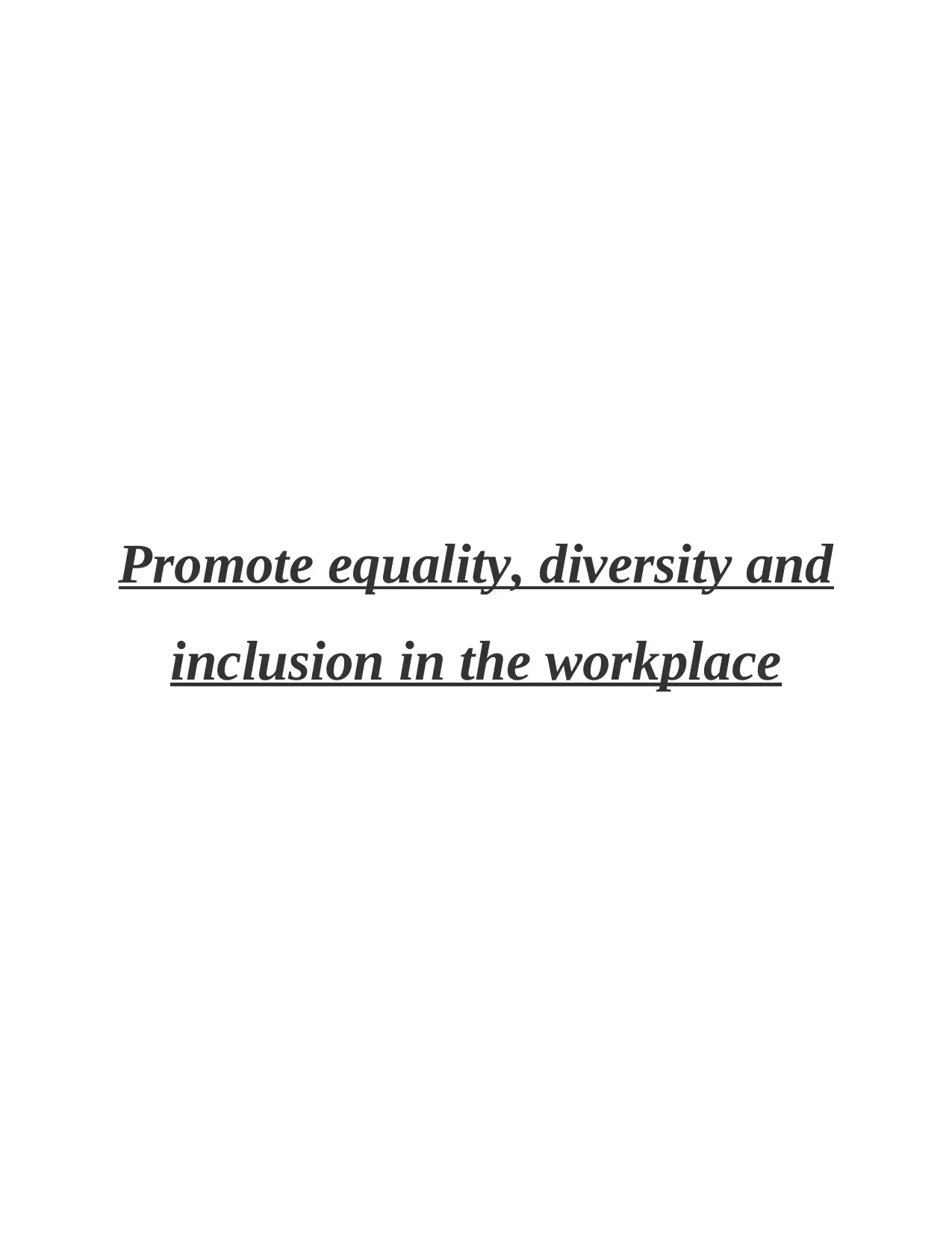
Promote equality, diversity and
inclusion in the workplace
inclusion in the workplace
Paraphrase This Document
Need a fresh take? Get an instant paraphrase of this document with our AI Paraphraser
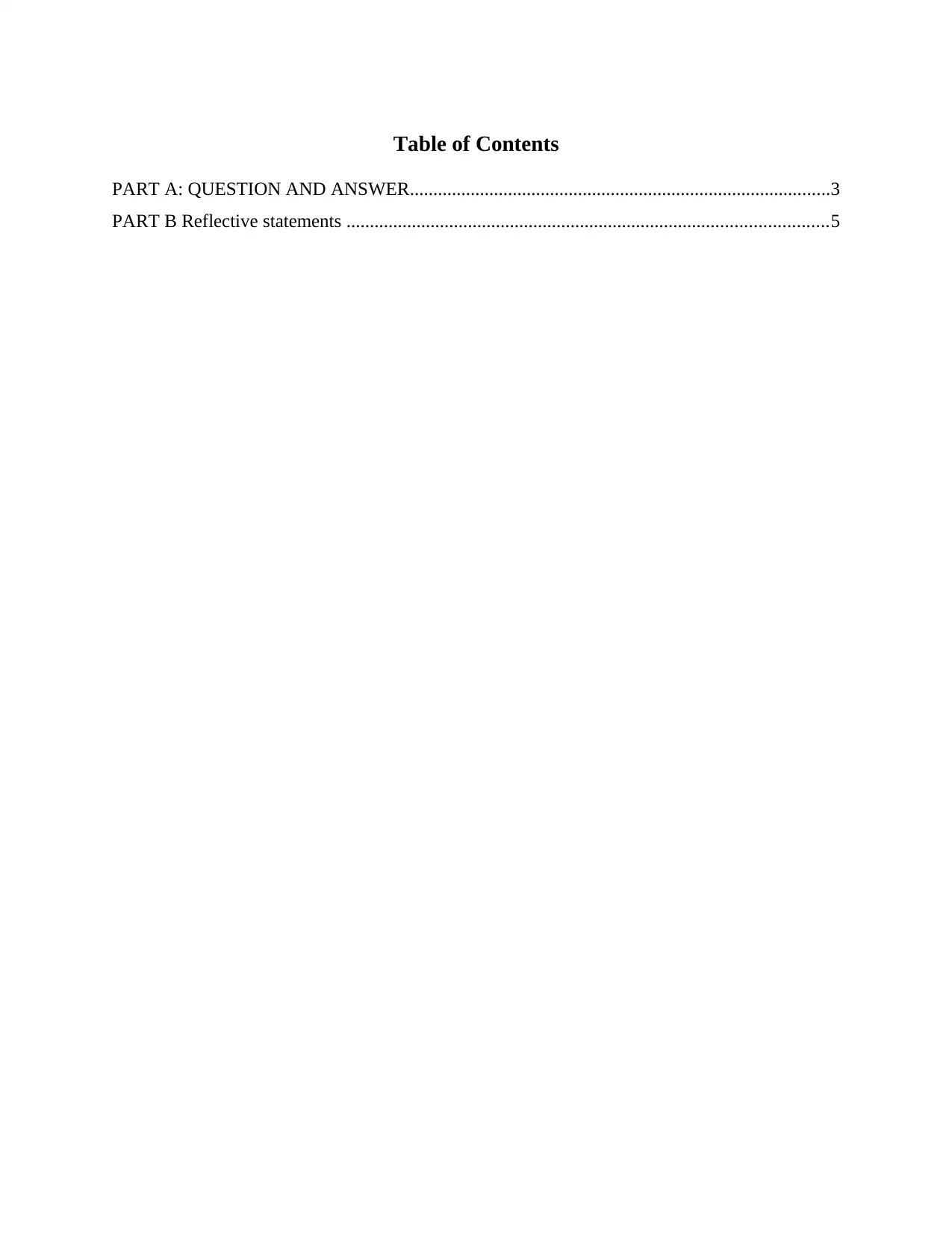
Table of Contents
PART A: QUESTION AND ANSWER..........................................................................................3
PART B Reflective statements .......................................................................................................5
PART A: QUESTION AND ANSWER..........................................................................................3
PART B Reflective statements .......................................................................................................5
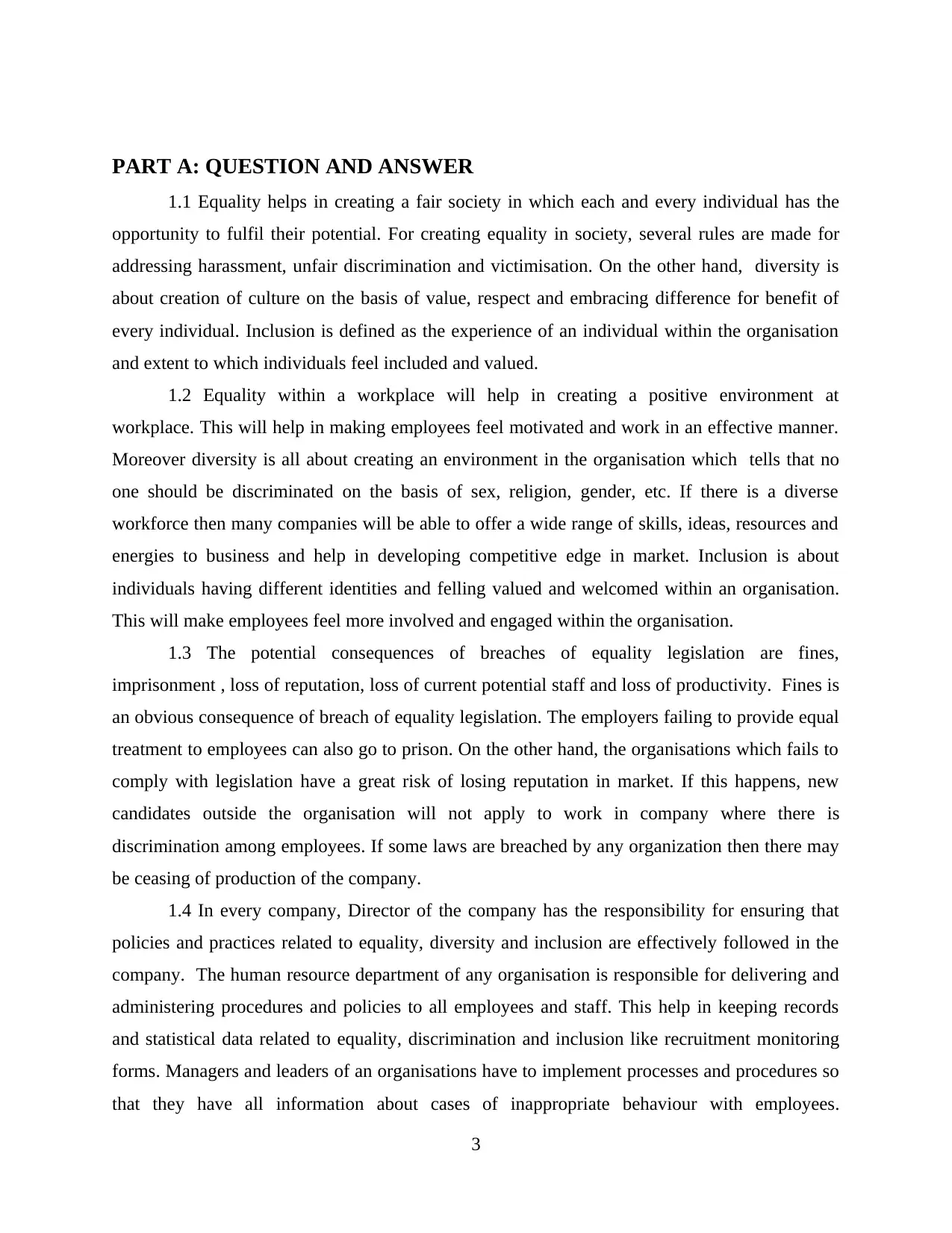
PART A: QUESTION AND ANSWER
1.1 Equality helps in creating a fair society in which each and every individual has the
opportunity to fulfil their potential. For creating equality in society, several rules are made for
addressing harassment, unfair discrimination and victimisation. On the other hand, diversity is
about creation of culture on the basis of value, respect and embracing difference for benefit of
every individual. Inclusion is defined as the experience of an individual within the organisation
and extent to which individuals feel included and valued.
1.2 Equality within a workplace will help in creating a positive environment at
workplace. This will help in making employees feel motivated and work in an effective manner.
Moreover diversity is all about creating an environment in the organisation which tells that no
one should be discriminated on the basis of sex, religion, gender, etc. If there is a diverse
workforce then many companies will be able to offer a wide range of skills, ideas, resources and
energies to business and help in developing competitive edge in market. Inclusion is about
individuals having different identities and felling valued and welcomed within an organisation.
This will make employees feel more involved and engaged within the organisation.
1.3 The potential consequences of breaches of equality legislation are fines,
imprisonment , loss of reputation, loss of current potential staff and loss of productivity. Fines is
an obvious consequence of breach of equality legislation. The employers failing to provide equal
treatment to employees can also go to prison. On the other hand, the organisations which fails to
comply with legislation have a great risk of losing reputation in market. If this happens, new
candidates outside the organisation will not apply to work in company where there is
discrimination among employees. If some laws are breached by any organization then there may
be ceasing of production of the company.
1.4 In every company, Director of the company has the responsibility for ensuring that
policies and practices related to equality, diversity and inclusion are effectively followed in the
company. The human resource department of any organisation is responsible for delivering and
administering procedures and policies to all employees and staff. This help in keeping records
and statistical data related to equality, discrimination and inclusion like recruitment monitoring
forms. Managers and leaders of an organisations have to implement processes and procedures so
that they have all information about cases of inappropriate behaviour with employees.
3
1.1 Equality helps in creating a fair society in which each and every individual has the
opportunity to fulfil their potential. For creating equality in society, several rules are made for
addressing harassment, unfair discrimination and victimisation. On the other hand, diversity is
about creation of culture on the basis of value, respect and embracing difference for benefit of
every individual. Inclusion is defined as the experience of an individual within the organisation
and extent to which individuals feel included and valued.
1.2 Equality within a workplace will help in creating a positive environment at
workplace. This will help in making employees feel motivated and work in an effective manner.
Moreover diversity is all about creating an environment in the organisation which tells that no
one should be discriminated on the basis of sex, religion, gender, etc. If there is a diverse
workforce then many companies will be able to offer a wide range of skills, ideas, resources and
energies to business and help in developing competitive edge in market. Inclusion is about
individuals having different identities and felling valued and welcomed within an organisation.
This will make employees feel more involved and engaged within the organisation.
1.3 The potential consequences of breaches of equality legislation are fines,
imprisonment , loss of reputation, loss of current potential staff and loss of productivity. Fines is
an obvious consequence of breach of equality legislation. The employers failing to provide equal
treatment to employees can also go to prison. On the other hand, the organisations which fails to
comply with legislation have a great risk of losing reputation in market. If this happens, new
candidates outside the organisation will not apply to work in company where there is
discrimination among employees. If some laws are breached by any organization then there may
be ceasing of production of the company.
1.4 In every company, Director of the company has the responsibility for ensuring that
policies and practices related to equality, diversity and inclusion are effectively followed in the
company. The human resource department of any organisation is responsible for delivering and
administering procedures and policies to all employees and staff. This help in keeping records
and statistical data related to equality, discrimination and inclusion like recruitment monitoring
forms. Managers and leaders of an organisations have to implement processes and procedures so
that they have all information about cases of inappropriate behaviour with employees.
3
⊘ This is a preview!⊘
Do you want full access?
Subscribe today to unlock all pages.

Trusted by 1+ million students worldwide
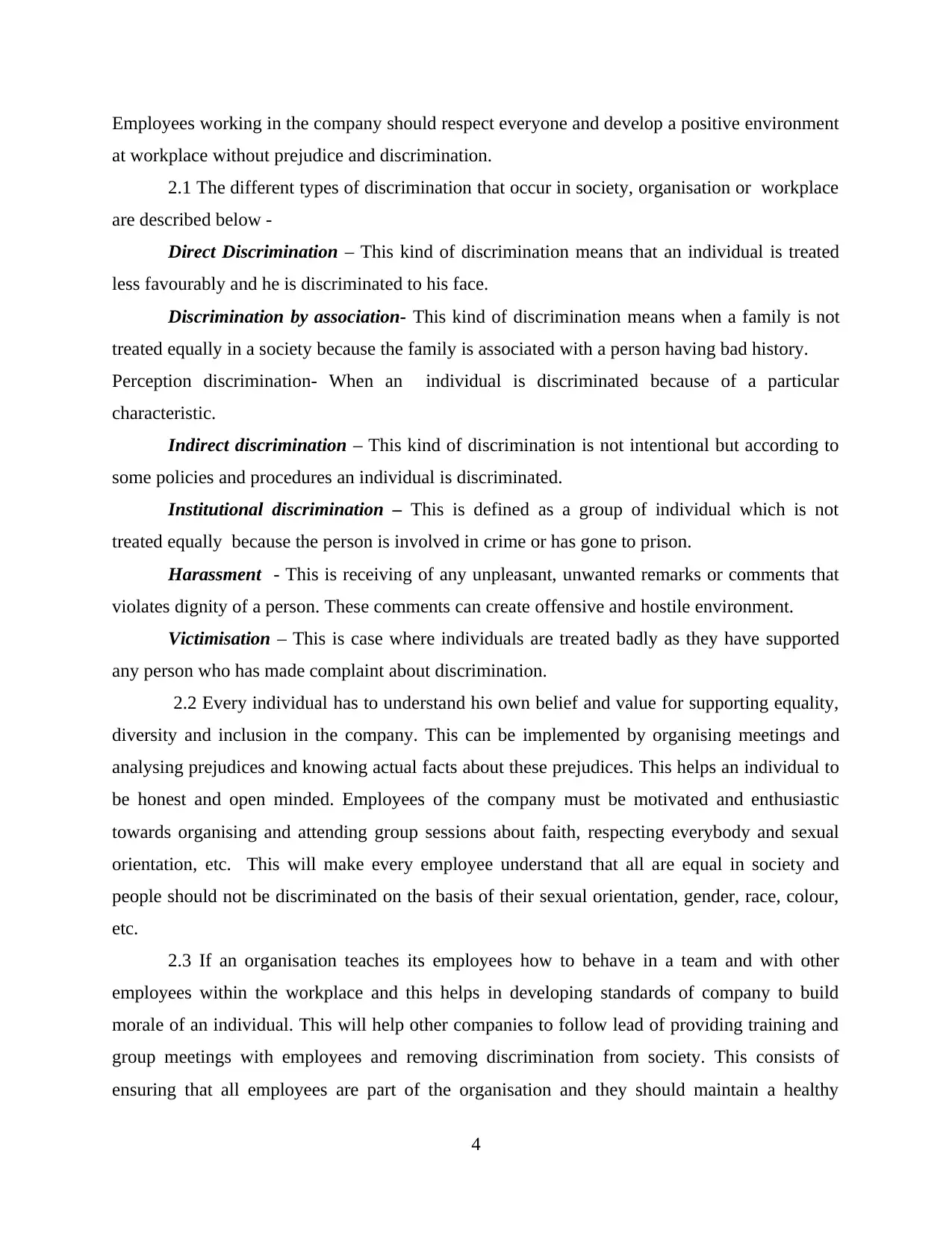
Employees working in the company should respect everyone and develop a positive environment
at workplace without prejudice and discrimination.
2.1 The different types of discrimination that occur in society, organisation or workplace
are described below -
Direct Discrimination – This kind of discrimination means that an individual is treated
less favourably and he is discriminated to his face.
Discrimination by association- This kind of discrimination means when a family is not
treated equally in a society because the family is associated with a person having bad history.
Perception discrimination- When an individual is discriminated because of a particular
characteristic.
Indirect discrimination – This kind of discrimination is not intentional but according to
some policies and procedures an individual is discriminated.
Institutional discrimination – This is defined as a group of individual which is not
treated equally because the person is involved in crime or has gone to prison.
Harassment - This is receiving of any unpleasant, unwanted remarks or comments that
violates dignity of a person. These comments can create offensive and hostile environment.
Victimisation – This is case where individuals are treated badly as they have supported
any person who has made complaint about discrimination.
2.2 Every individual has to understand his own belief and value for supporting equality,
diversity and inclusion in the company. This can be implemented by organising meetings and
analysing prejudices and knowing actual facts about these prejudices. This helps an individual to
be honest and open minded. Employees of the company must be motivated and enthusiastic
towards organising and attending group sessions about faith, respecting everybody and sexual
orientation, etc. This will make every employee understand that all are equal in society and
people should not be discriminated on the basis of their sexual orientation, gender, race, colour,
etc.
2.3 If an organisation teaches its employees how to behave in a team and with other
employees within the workplace and this helps in developing standards of company to build
morale of an individual. This will help other companies to follow lead of providing training and
group meetings with employees and removing discrimination from society. This consists of
ensuring that all employees are part of the organisation and they should maintain a healthy
4
at workplace without prejudice and discrimination.
2.1 The different types of discrimination that occur in society, organisation or workplace
are described below -
Direct Discrimination – This kind of discrimination means that an individual is treated
less favourably and he is discriminated to his face.
Discrimination by association- This kind of discrimination means when a family is not
treated equally in a society because the family is associated with a person having bad history.
Perception discrimination- When an individual is discriminated because of a particular
characteristic.
Indirect discrimination – This kind of discrimination is not intentional but according to
some policies and procedures an individual is discriminated.
Institutional discrimination – This is defined as a group of individual which is not
treated equally because the person is involved in crime or has gone to prison.
Harassment - This is receiving of any unpleasant, unwanted remarks or comments that
violates dignity of a person. These comments can create offensive and hostile environment.
Victimisation – This is case where individuals are treated badly as they have supported
any person who has made complaint about discrimination.
2.2 Every individual has to understand his own belief and value for supporting equality,
diversity and inclusion in the company. This can be implemented by organising meetings and
analysing prejudices and knowing actual facts about these prejudices. This helps an individual to
be honest and open minded. Employees of the company must be motivated and enthusiastic
towards organising and attending group sessions about faith, respecting everybody and sexual
orientation, etc. This will make every employee understand that all are equal in society and
people should not be discriminated on the basis of their sexual orientation, gender, race, colour,
etc.
2.3 If an organisation teaches its employees how to behave in a team and with other
employees within the workplace and this helps in developing standards of company to build
morale of an individual. This will help other companies to follow lead of providing training and
group meetings with employees and removing discrimination from society. This consists of
ensuring that all employees are part of the organisation and they should maintain a healthy
4
Paraphrase This Document
Need a fresh take? Get an instant paraphrase of this document with our AI Paraphraser
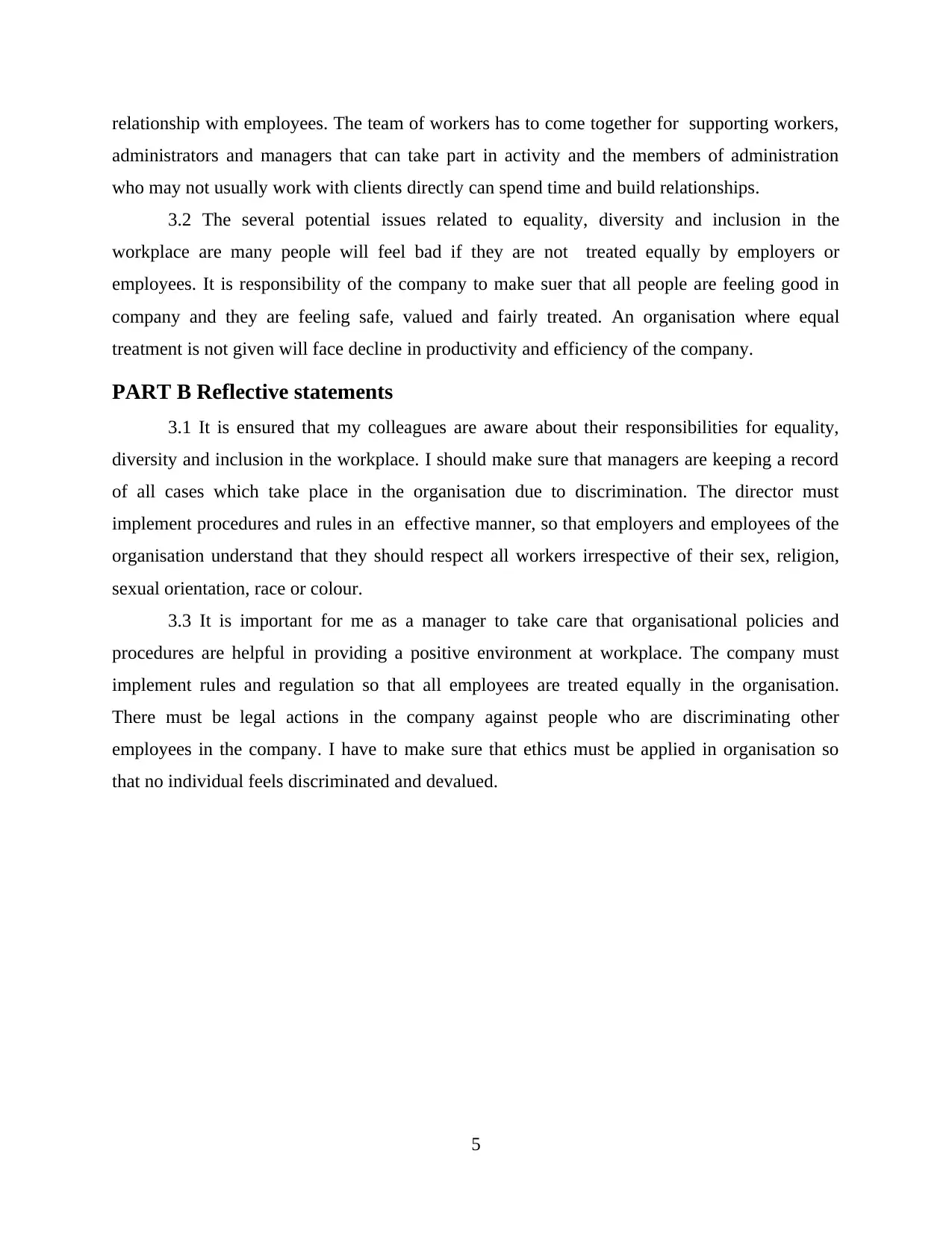
relationship with employees. The team of workers has to come together for supporting workers,
administrators and managers that can take part in activity and the members of administration
who may not usually work with clients directly can spend time and build relationships.
3.2 The several potential issues related to equality, diversity and inclusion in the
workplace are many people will feel bad if they are not treated equally by employers or
employees. It is responsibility of the company to make suer that all people are feeling good in
company and they are feeling safe, valued and fairly treated. An organisation where equal
treatment is not given will face decline in productivity and efficiency of the company.
PART B Reflective statements
3.1 It is ensured that my colleagues are aware about their responsibilities for equality,
diversity and inclusion in the workplace. I should make sure that managers are keeping a record
of all cases which take place in the organisation due to discrimination. The director must
implement procedures and rules in an effective manner, so that employers and employees of the
organisation understand that they should respect all workers irrespective of their sex, religion,
sexual orientation, race or colour.
3.3 It is important for me as a manager to take care that organisational policies and
procedures are helpful in providing a positive environment at workplace. The company must
implement rules and regulation so that all employees are treated equally in the organisation.
There must be legal actions in the company against people who are discriminating other
employees in the company. I have to make sure that ethics must be applied in organisation so
that no individual feels discriminated and devalued.
5
administrators and managers that can take part in activity and the members of administration
who may not usually work with clients directly can spend time and build relationships.
3.2 The several potential issues related to equality, diversity and inclusion in the
workplace are many people will feel bad if they are not treated equally by employers or
employees. It is responsibility of the company to make suer that all people are feeling good in
company and they are feeling safe, valued and fairly treated. An organisation where equal
treatment is not given will face decline in productivity and efficiency of the company.
PART B Reflective statements
3.1 It is ensured that my colleagues are aware about their responsibilities for equality,
diversity and inclusion in the workplace. I should make sure that managers are keeping a record
of all cases which take place in the organisation due to discrimination. The director must
implement procedures and rules in an effective manner, so that employers and employees of the
organisation understand that they should respect all workers irrespective of their sex, religion,
sexual orientation, race or colour.
3.3 It is important for me as a manager to take care that organisational policies and
procedures are helpful in providing a positive environment at workplace. The company must
implement rules and regulation so that all employees are treated equally in the organisation.
There must be legal actions in the company against people who are discriminating other
employees in the company. I have to make sure that ethics must be applied in organisation so
that no individual feels discriminated and devalued.
5
1 out of 5
Related Documents
Your All-in-One AI-Powered Toolkit for Academic Success.
+13062052269
info@desklib.com
Available 24*7 on WhatsApp / Email
![[object Object]](/_next/static/media/star-bottom.7253800d.svg)
Unlock your academic potential
Copyright © 2020–2025 A2Z Services. All Rights Reserved. Developed and managed by ZUCOL.





